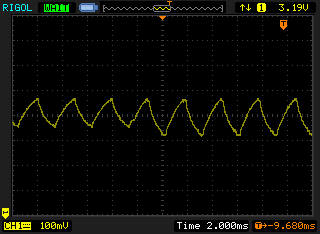I've got this circuit with 3x atmega328 & nrf24l01+ running off shared power supply, either 2x AA battery or 3v3 reg.
It acts as a repeater, and depending on the origin of the message and the destination it could be passed through all 3 radios on its way. And sometimes when I send signals through it, they don't get to their destination.
Generally at higher PA (power amplifier) settings it is less reliable, though I don't think its RF interference as I have tried them at varying distance from with each other with little change. Also if I run all 3 separate on their own batteries, I can have them as close as I can get, right next to each other and it works fine at max PA.
I think it is more power related. I have tried big electrolytic cap on power supply and 100nF on the module them self.
On my scope I have seen various interference pattern in the voltage supply, as pictured.
Generally I see patterns like this at same time message have trouble reaching their destination.
One radio/328 by itself is not a problem, it seems when they all run off the same supply each of their individual ripple is combined to make something that has effect.
I am hoping someone can look at the capture and recommend something?
*edit, added 2nd grab.
100N cap:

470uf cap:

2x470uF on each, scope on cap leg:


